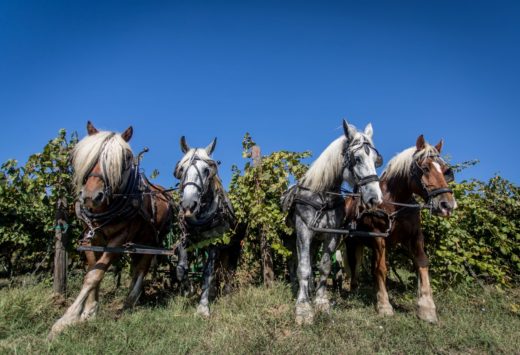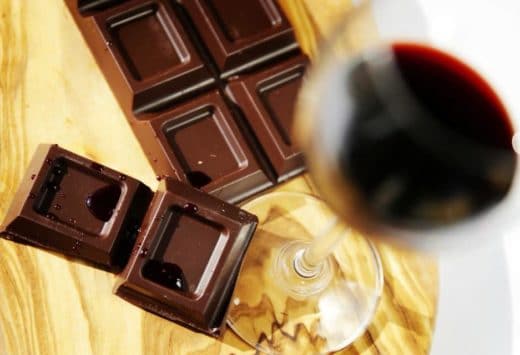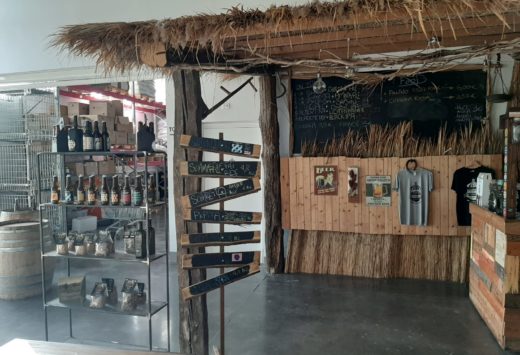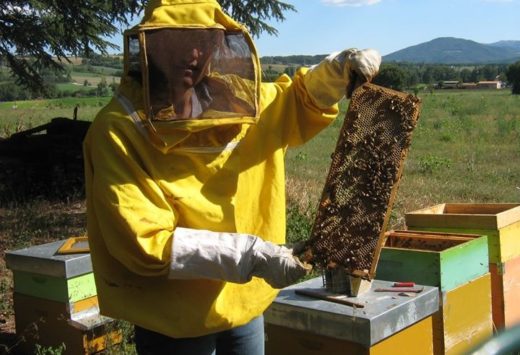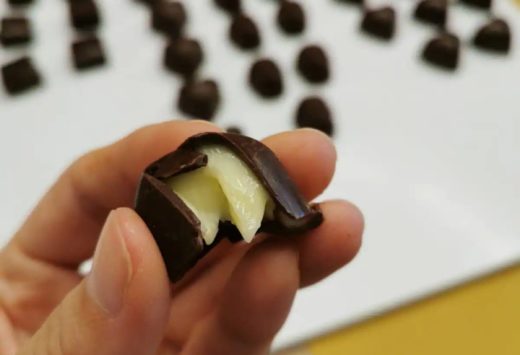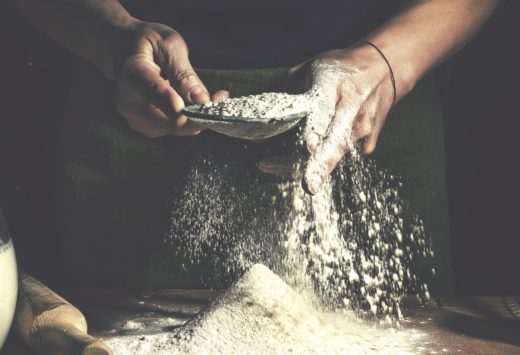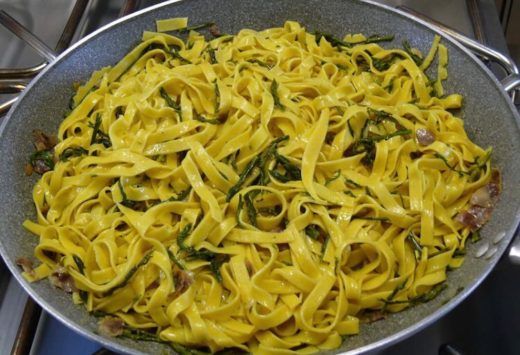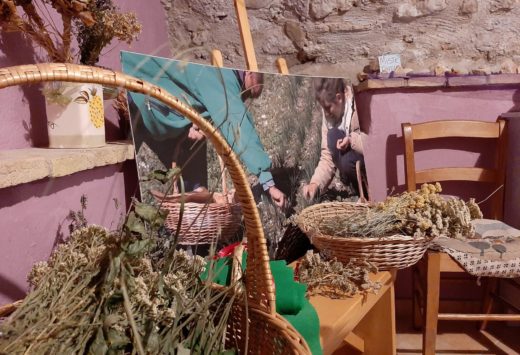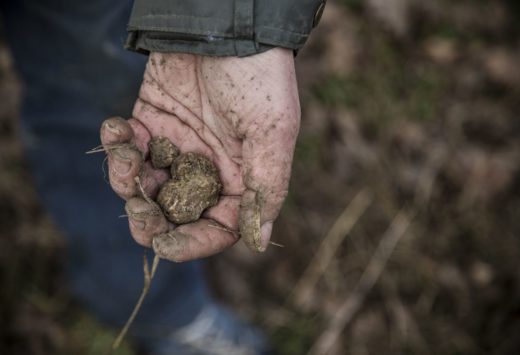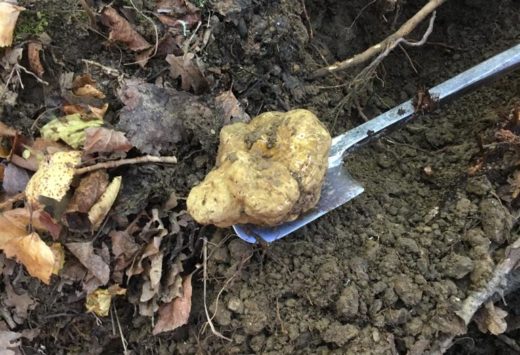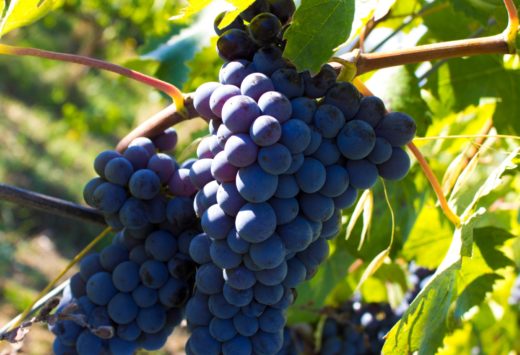Fava Cottora
This special type of broad bean grows in the municipalities of Guardea and Amelia in the province of Terni. Its main feature is its quick and thorough cooking time, without the need for previous hulling. These qualities are reputedly conferred by the land it grows on, which is almost free of active limestone. Apparently, the seed of the plant was selected by the families in the area over decades to identify the most suitable type for the territory. The harvest takes place in July, when the plant has already dried out, and it is completely pulled out of the ground. The cooking process generally requires boiling and then setting aside for up to twenty-four hours, after which the hard beans can be picked out and discarded.
Ficchi Girotti
Girotti figs are a speciality of Amelia. They are dried and stuffed with dried fruit, nuts and chocolate. They are named after the family that has prepared them in this way since 1830 and has contributed to increasing their fame, but their origins are probably much older. Legend has it that the dried figs of Amelia were so delicious as to be frequently presentated at table to the popes.
Rocciata
Rocciata, a strudel-like pastry, is typical of the areas of Assisi and Foligno, including the nearby mountains. Its origins are seemingly ancient, probably dating back to the Umbrian civilization, as attested by references to a very similar product on the ‘eugubine tables’ (about 3rd century BC).
Rocciata is composed of thin puff pastry containing apples, various combinations of dried fruit, olive oil and sugar. Versions with added jam, cocoa, cinnamon or alkermes are also allowed.
In some areas of Umbria this pastry is known as ‘ntorta’ or ‘attorta’ and some of the ingredients may vary.
Spelt
In addition to the spelt of Monteleone di Spoleto, awarded official DOP recognition, the whole territory of Umbria is suitable for the cultivation of this type of wheat. Apparently, it was cultivated in Umbria as early as the 2nd century BC by the Romans. Today spelt is often encountered on Umbrian tables, and is used to make flour, pasta and desserts, but is added specially to soups or to make the famous spelt salad which is often found as an appetizer in traditional fare.
Honey
Beekeeping is strongly rooted in the Umbrian farming tradition and has age-old origins. Ancient Umbrians and Etruscans produced a lot of honey in these areas, with techniques that were subsequently also adopted and perfected by the Romans. The most common varieties are Acacia and Castagno (Chestnut flower), but the most characteristic honey is the region’s millefiori (wildflower), with qualities that are also highly appreciated by experts in the field.
Truffles
As is probably well-known, the truffle is part of the mushroom genus, part of the tuberaceous family. It grows spontaneously under specific trees, in most cases oaks and holm oaks. It has the well-deserved reputation of being a particularly delicious food, but with a high cost, depending on the type of truffle purchased.
In the ancient world, its origins were explained in the most weird and wonderful ways. It was believed, in fact, to be born of a combination of water, heat and lightning, and that the first truffle was born of Jupiter’s thunderbolt, which struck near an oak tree. During the Renaissance period, an Umbrian doctor, Alfonso Ceccarelli, explained its origins, anecdotes and properties in a volume called Opusculus de Tuberis (1564).
There are truffles of varying qualities, shape, size and organoleptic properties. The finest is the white truffle, followed by the premium black truffle, the moscato truffle, the summer (or ‘scorzone’) truffle, the ‘uncinato’ and the ‘bianchetto’ (there are other minor species, which in some cases are not even marketable).
The land-types in Umbria are well-suited to the development of all types of edible truffles. The white truffle, for example, is grown very successfully on this region’s soil, but it is in the valuable black truffle, called Nero di Norcia, that the territory expresses its highest potential. Calcareous and clayey soils, rich in beech, chestnut, oak and holm oaks, create ideal conditions for the development of this type of truffle and make the region the most profitable in producing it. Besides being famous for its strong flavour, the ‘Nero di Norcia’ truffle is known, above all, as being the only type that maintains its organoleptic properties even during cooking, allowing its use in various recipes which have now become cornerstones of the local culinary tradition.
The summer truffle, or ‘scorzone’, is also very common in Umbria and is used in various recipes, but especially in sauces and as a seasoning in sausages.
Porchetta Umbra
Porchetta (pork roast) is a typical dish found throughout central Italy, but the Umbrian style is distinct from the classic version due to its seasoning, preparation methods and cooking times, making it a distinct product, identifiable as the one and only ‘Porchetta Umbra’.
Porchetta is produced more or less throughout Umbria, even if some very local production has highly distinctive elements. Generally, it consists of a whole deboned roasted pig which is first prepared by emptying the carcass of the entrails. These are cooked separately and then reinserted at a later point, then the pig is seasoned with salt, pepper, garlic and wild fennel (and sometimes other spices), is closed up, tied to a spit and roasted in the oven (traditionally wood-burning) for 6-8 hours. During roasting, the ‘porchettaro’ or pork chef collects the fat that is released (called ‘ntocco’) in a pan and uses it to baste the pork while it continues to roast. This procedure helps to give crispness to the ‘crosta’ (crackling).
Porchetta can be found almost everywhere in Umbria, from street vendors, to festivals, small butchers and local grocery shops. Its uniqueness and lip-smacking flavour have been raved over by reviewers and journalists in articles and on TV in Italy, as well as by the international press. The New York Times, for example, has twice dedicated column space to Umbrian porchetta. The first time it was included in the ‘must eat dishes’ in an article of the same name, and a second time in an article describing Umbrian porchetta and how it is celebrated in the ‘Porchettiamo’ festival that takes place in San Terenziano, which attracts most of the regional producers of porchetta (and many from beyond) in a magnificent celebration of aroma and flavour.
When it comes to porchetta, however, most Umbrians associate it with the name of Costano, a small village in the municipality of Bastia Umbra known throughout the territory for the famous ‘sagra della porchetta’. This is a 10-day celebration offering traditional specialities but above all porchetta, seasoned and cooked strictly according to the rules of the local customs. On occasions, in fact, Costano also produces the less common un-boned variation of porchetta. The festival in this village is the direct result of a fiercely-proud and deeply-rooted tradition of porchetta, making it famous throughout Umbria and beyond.
Cipolla di Cannara
The cultivation of the onion from Cannara, a municipality in the territory of Assisi, has ancient origins, fostered above all by the structure of the area’s land and soil type. Even today, local production of onions is continued by family farms and the harvest is mainly manual.
Planting takes place in February and once when the plants reach the height of about 5 or 10 cm, generally in July, harvesting begins, consisting of the extraction of the bulb and the collection in bundles tied with string, which are left on the ground joined together, out of direct exposure to sunlight. This phase allows the bulb to fully ripen the stem to dry out. After about 3 weeks, the bundles are collected and hung up. One of the famous methods of packaging the onions is to interweave them together in a plait, using the dried stem of the plant itself.
The Cannara onion is usually grown in 3 varieties: red, golden and the pale, rather flat ‘borretana’.
Throughout Umbria, the word Cannara is always associated with the onion, not so much because of the large-scale cultivation of this product in the area, but for the onion festival called the ‘sagra della cipolla’ held every year in September in the centre of the village. The festival lasts about 10 days and winds its way along all the narrow streets, in a kaleidoscope of people, aromas and colours. The star of the show is the onion and the fame of this festival is well deserved. It differs from the others because the menu offered by the stands (which open for the occasion and are manned by people from that particular hamlet) is based almost entirely on the onion. There are variants of the usual parmigiana, fried onions, first courses, meat dishes, omelettes and even desserts, all prepared with onions. If you are in Umbria in September, this is definitely worth a visit.
Patata De.Co. di Pietralunga
The white potato from Pietralunga has been awarded De.Co. certification (a municipal designation of origin), recognizing it as a typical product of the municipal territory. The Pietralunga potato has earned this recognition thanks to the local soil’s special characteristics, being rich in potassium and well-drained and, above all, located at an elevation of more than 500 m a.s.l. As it’s very floury, this type of potato is particularly suitable for making gnocchi.
Saffron
Saffron is a spice extracted from the flower of the same name originating in Asia, probably from India. Used mainly for painting and colouring, it was imported by the Spaniards but in Europe, and especially in Italy, it found various terroirs in which its flower could thrive.
It seems to have arrived in Umbria around the 13th century, as evidenced by documents of the time. Today it is mainly produced in the areas of Città della Pieve, Cascia, Gubbio and Spoleto.
Perhaps the most ancient tradition can be attributed to Città della Pieve, where the oldest traces of the spice date back to 1279, whilst Cascia also boasted widespread cultivation between the 13th and 15th centuries. To protect this crop and its traditions, various associations have been created which enable interested individuals to participate in the harvest.
Torta al testo or Crescia
If we were to choose a symbol of the Umbrian culinary tradition, or find its most representative product, this would certainly be the bread called Torta al Testo. Appreciated by all Umbrians, in certain areas such as Gubbi and on the Apennines towards the border with Marche, it is called crescia, while in others, such as in the Città di Castello area, caccia. However, the name it is known by throughout the territory is ‘Torta la Testo’.
Every single Umbrian family has a closely-guarded secret recipe and so the bread may vary somewhat, but it is still instantly recognizable: it may look like a focaccia, but it’s more compact, or like a ‘piadina’, but it’s softer and thicker. It has ancient origins in the area and was already made in Roman times, where a mixture of flour and water was cooked on a slab of brick (like a tile) called ‘testum’ and heated over coals. Today the word ‘testo’ refers to the flat cast-iron pan used for cooking the dough, which in the traditional version is made of flour, water and salt. It is cooked on red-hot coals. In some homes, lard is added, in others, eggs. Tasting each variant is a must!
It can be eaten as a simple sort of bread or stuffed with any type of meat or cold cut, while typical Umbrian pairings are usually with dry-cured ham, cooked greens (usually a mixture of chicory and spinach) and roasted sausages, sausages on their own, stracchino cheese and rocket, salami or ‘ciauscolo’ porchetta. It is also served to accompany offal.
Ciauscolo
A well-known speciality, mostly from the Umbrian-Le Marche region of the Apennines. In the Umbrian part, it is more common in the municipality of Colfiorito. It is a fresh sausage, similar to a salami, perhaps even of Longobard origin, and is still a very local tradition and hardly ever sold by large retailers. It is usually used to stuff the ‘Torta al Testo’ or served like bruschetta. In any case, this is a flavour sensation not to be missed!
Fagiolo di Cave
Cave is a hamlet in the municipality of Foligno with about 400 inhabitants. The Cave bean is produced here in 2 varieties, yellow and green, and both are extremely rare. Production today is very limited compared to the past, partly due to the low profitability of the sector, making this type of bean a rarity.
Cultivation takes place in a natural way and the soil’s intrinsic properties confer a completely unique flavour to the bean, with intensely fragrant aromas and strong flavours.
Sedano Nero di Trevi
This type of dark celery (literally ‘black’ in Italian), has been grown in the Trevi area since ancient times on highly-suited land crossed by the Clitunno river. Nowadays, cultivation is carried out via strictly traditional methods, proudly safeguarded by local farmers.
These days, production is severely limited compared to the past, mainly due to the advent of American celery which, however, makes Trevi’s sedano nero very rare and sought-after. The name derives from the fact that when left to grow without proper planting, this vegetable turns a dark green colour, although the current process interrupts this unusual pigmentation. The ribs are longer than those of classic celery and can reach over one metre, but the most distinctive feature is the total absence of the annoying threads exhibited by classic celery. Every year in Trevi a series of dishes made with celery are showcased during the village sagra.
Liquore di Vino Rosso e Viscole
In some areas of Umbria, this liqueur is made with red wine and visciole, sour cherries. The most well-known areas for production are Pietralunga and the Orvieto area.
Torta di Pasqua
Torta di Pasqua is a widespread speciality throughout the region. As the name suggests, this pie is produced exclusively during Easter and is highly appreciated by all Umbrians who, highly respectful of local customs, always eat a few slices during this period. In many parts of the region, tradition even dictates that on the morning of Easter Sunday, a savoury breakfast is served, made up of cold meats, almost always Umbrian capocollo, hard-boiled eggs, wine and this Easter pie.
It is made by mixing flour, water, oil, eggs and raising agent with selected cheeses (traditionally Parmesan, Pecorino and Gruyere). The result is a very tasty pie shaped like a panettone.
Lumachella
Typical of the Orvieto area, lumachella is a savoury pastry that can be eaten hot or cold. The small flans are made of flour, water, lard, oil, pecorino cheese, pepper and diced bacon. It is named after its shape, a snail, made by rolling up strips of pastry.
Groppone di Ficulle
Groppone di Ficulle is a typical salami from the village of Ficulle. It is made with pork loin mainly from the Cinta Senese breed of pig. Preparation usually takes place 24 or 48 hours after slaughter. The meat is then massaged with a spice rub soaked in red wine. Subsequently it is sprinkled with pepper and completely covered with salt. After a few days, the Groppone is rubbed with a mixture of water and wine, then covered with lard and pepper and left to age for some 10 – 12 months
Pera di Monteleone
The Monteleone pear comes from a robust, rustic tree of medium size and weighs between 140 – 160 g. It is conical in shape and has a smooth yellow skin that is dappled with small, rust-coloured spots.
It is grown throughout the Orvieto district, but is probably from Monteleone, as claimed in a document written by Castore Durante da Gualdo.
Being very fleshy and high in calories, it is ideal for making desserts, conferring an unusually intense taste after cooking.
Torcolo di San Costanzo
This traditional cake is typically from the Perugia area. In this province, the word ‘torcolo’ usually refers to a ring-cake, which can be found with some variations. This variant, dedicated to St. Costanzo, one of Perugia’s patron saints, is prepared with a mixture of flour, water, sugar, oil and butter, with the addition of sultanas, candied fruit, pine nuts and anise seeds. It looks very much like a large rustic doughnut. It is a very popular sweet in the area and can be found during village festivals or in Perugian homes in the period around St. Costanzo, celebrated on 29th January, although it can easily be bought all year round.
Its origins seem to date back to the 16th century, when bakers produced huge quantities to distribute it free-of-charge to the population, in what became a sort of Renaissance-era ‘bake-off’!
Pinoccate
Pinoccate are a typical regional sweet but tied more closely to the traditions of the province of Perugia.
They are only eaten during the Christmas period and are shaped like small diamonds, each about 5-6 cm long. Traditionally the mixture, laid out on a marble slab, is made of sugar diluted with water and boiled, with added pine nuts and grated lemon peel. It is shaped into diamonds with the blade of a knife once the mixture’s cooling point has been reached. There are two versions: ‘black’ and white. Cocoa powder is added to make the second version.
Pan Caciato or Pan Nociato
Pan caciato, or pan nociato, is known throughout Umbria, but is particularly popular in the areas of Todi and Perugia. They are small loaves of bread made with a mixture of water, flour and oil, with the addition of pecorino, walnuts and pepper. Some variants also contain sultanas.
Brustengolo
Perhaps one of the city of Perugia’s most traditional sweets, this cake is made with fine maize meal and dried fruit and is usually rectangular or round. It has a typically golden yellow colour due to the maize meal, and pine nuts, raisins and in some cases even dried figs are added.
In this case, too, the tradition, as the ingredients suggest, is basically rural. The aim, in fact, was to provide a sweet treat for poor families during cold seasons. Over time, the cake has become increasingly popular and well known.
Pammelati
These sweets are again typical of the Christmas period and have a rounded but elongated egg shape, like supplì croquettes. They are made with breadcrumbs, honey, orange zest and walnuts mixed in a pot and then rolled on a marble surface to give them the right shape. They originated in Torgiano and Deruta.
Crescionda
Crescionda is a typical, traditional cake from Spoleto prepared during carnival time, but again, there are various versions.
Circular in shape, it is prepared with a mixture of crushed amaretti biscuits, milk, amaretto liqueur, dark chocolate, lemon zest, sugar and a little flour. The result is unusual but delicious.
The origins date back to the Middle Ages, but the original recipe has become practically unrecognisable. Initially, hen broth or cheese was also used to provide a sweet-and-sour flavour, but in more modern times the recipe has gradually shifted to a more exclusively sweet version.
Pane di Strettura
The same type of oven, the same recipe, the same cooking method and the same sourdough starter: these are what make this bread from Strettura one of the region’s most popular specialities. The tradition has been handed down from this small oven since 1870, the day of its opening. In the village of Strettura, the bread is literally made the old-fashioned way. The wood-burning oven respects the process and the timing used over a century ago, and the absence of salt places the bread at the heart of regional tradition. According to this, bread should be tasteless, perhaps as a legacy of the tax imposed on salt by Pope Paul III, or because it makes the bread supremely suited to accompany the region’s already very savoury and tasty sausage varieties. Or maybe for both reasons!
Panpepato
Panpepato is a traditional cake from Terni. Circular in shape and dense in consistency, it is made with nuts and dried fruit (almonds, walnuts, hazelnuts and raisins) added to a mixture of chocolate, cinnamon, nutmeg, coffee, flour, honey and cooked must.
Its origins are said to date back to the 16th century, when the importing of spices from Asia also saw the arrival of a very similar cake to the present panpepato. The tradition in Terni, however (which has similarities with the Siena area), has modified the recipe, enriching it with local produce such as walnuts, citrus fruits and cooked must.
Salsa Ghiotta di Terni
This sauce is used widely in the area of Terni to add flavour to meat dishes, especially game. Its preparation is rather simple and suggests that its purpose was to avoid wasting any part of the animal: the fat is collected after cooking the meat, and bacon, oil, wine, vinegar, capers, rosemary, anchovies, onion, garlic, sage, juniper berries or cloves and lemon juice are added.
Corallina
Corallina is a typical salami from Umbria, especially from the southern part. It belongs to an ancient rural tradition and is prepared by selecting lean pork meats and grinding them to obtain a very fine paste, with the addition of diced fat. In some cases, it is smoked, but in general the curing process respects Umbrian tradition. Originally prepared by experts from Norcia to be eaten mainly at Easter, nowadays its success is also due to its availability in supermarkets.
Ciriole alla Ternana
This is a traditional pasta from Terni, which derives from the humblest rural foodstuffs. Prepared simply with flour and water, it has an elongated shape like spaghetti but is much thicker.
Fagiolina del Trasimeno
The Trasimeno bean is particularly small and grows in the land around Lake Trasimeno. It can vary in colour from cream to coffee to speckled.
Production is very limited now compared to the past, partly due to depopulation in these areas but also because of the labour-intensive nature of the harvest which is strictly manual.
At the moment, few producers remain but they are very resilient, even forming an association to create and promote a market for their produce. Every year in Castiglione del Lago, a festival is organized in honour of the Trasimeno bean, where you can enjoy various dishes prepared with this legume.
Broccoletti del Trasimeno
The land around Lake Trasimeno, which is sandy and particularly rich in nutrients, encourages the growth of various vegetables, some of which develop unique characteristics. One of these is Trasimeno broccoli. Interest in its cultivation is waning and it therefore risks extinction, but it is still a highly-appreciated vegetable due to its interesting, delicate flavour with slightly bitter notes.
Umbricelli
Umbricelli are a typical Umbrian pasta, prepared with a mixture of flour and water. They have an elongated shape, like thick spaghetti, and are often paired with local sauces such as truffle, wild boar or other game.
Strangozzi
Strangozzi are definitely the most common type of Umbrian pasta known throughout the region. They are similar to Umbricelli or Ciriole – made with a mixture of flour and water – and have an elongated spaghetti-like length, but the cross-section is square rather than circular. The are much more well-known because they are often served with the Nero di Norcia truffle. Strangozzi with truffles is, in fact, one of the most highly-appreciated and characteristic dishes in Umbrian cuisine because it embodies all the features of the regional culinary tradition: it is simple to prepare, respects its humble origins and is made with the region’s genuine, wholesome ingredients.
Maccheroni dolci
One of the most unique and unusual traditional Umbrian dishes is sweet macaroni. No, this is not a typo, this is just a plate of pasta, usually tagliatelle, which instead of being seasoned with a savoury sauce, is seasoned with a ‘sauce’ of walnuts, honey, breadcrumbs and cocoa powder. Again, there are variations on this dish, like the addition of alkermes or cinnamon, but the tastiness remains the same. Definitely worth a try.
Agnello scottadito
This lamb dish is known to be traditional in Lazio, but not many people know that it is also belongs to the Umbrian tradition. It is usually prepared with lamb cutlets which are left to marinate for about half an hour in garlic, rosemary and oil, and then cooked on the grill. The dish should be served very hot, hence the origin of the name, which refers to ‘scalded fingers’.
Game
Hunting, in general, is a very popular sport throughout the Umbria region, so it’s easy to come across game on dinner tables. There are many types of game served traditionally, but the most common include: wild boar and venison, which are used in both first and second courses, as well as sausages and/or cold cuts; guinea fowl, which is very common and is eaten accompanied by a paté made from its entrails served on croutons; pheasant, used in second courses and starters, mainly roasted and stewed; smaller birds, such as thrushes and quails, which are the most widely-hunted prey and are mainly roasted; pigeons and ringdoves, which are mainly stewed or baked, with the pigeon usually stuffed with meatloaf.
Ciaramicola
Ciaramicola is a typical Umbrian cake, especially from the province of Perugia, prepared during Easter. It’s a ring-cake but what’s striking is the colour: it’s light red, covered with a white ‘cloud’ and multi-coloured sprinkles. The cake is made with flour, eggs, sugar, a pinch of salt and raising agent, but the colour comes from the alkermes. The cloud, on the other hand, is simply a meringue made with egg whites covered with multi-coloured ‘hundreds and thousands’. It’s attractive, colourful, fun and above all delicious. The ciaramicola cake is also symbolic: it represents the city of Perugia with all its districts (the traditional version has five swirls of meringue), while the appearance recalls the red and white colours of the city.
Strufoli
Strufoli are exclusively Umbrian Easter cakes and should not to be confused with the Neapolitan version, which only shares the same name. Umbrian strufoli are prepared during the carnival period with a mixture of eggs, flour, sugar, yeast, rum, lemon zest, olive oil and milk. Tablespoons of dough are tossed into hot oil to be fried. They instantly take on an irregular spherical shape and when ready they are wonderfully crispy on the outside but soft on the inside. Once fried, strufoli are drizzled with honey that has previously been heated and whipped up. Whilst disarmingly simple, stufoli are a really unique treat. There can hardly be a single Umbrian who doesn’t eat strufoli at carnival time.
Arvoltolo
Arvoltolo is a typical Perugian speciality that’s difficult to define as either savoury or sweet because it can actually be both. In the first version salt is added after it’s cooked whereas in the second, sugar is added. The dough is a mixture of flour and oil and is rolled out into a disk shape measuring some 15-20 cm in diameter. It is fried in very hot oil and served hot or cold.
Appreciated and widespread throughout the area, its name derives from the word ‘arvoltare’, meaning ‘turn’ in the local dialect, since it needs turning a few times during frying.
Torciglione
Torciglione is an Umbrian sweet, typical of the Christmas period. Made with a mixture of almonds, sugar and egg white, it is then made into a bizzarre shape: a snake with its tongue out! The eyes are usually made out of coffee beans and the tongue is made with an almond or sugared almond, depending on the creativity of its maker.
This sweet has a distinctly symbolic meaning, with origins that seem to date as far back as the Middle Ages or even earlier, since the Umbrian snake, which actually symbolizes the eel of Lake Trasimeno, was a pagan symbol of regeneration and rebirth. Legend also has it that it was first prepared by the nuns on Lake Trasimeno’s largest island for some papal emissaries. Having no fish available, they decided to use what they had in their pantry, giving it the shape of an eel and calling it ‘anguilla del lago’ (lake eel).
Imbrecciata
In Umbria, the word ‘imbrecciata’ is used to refer to a soup made with legumes and refers to its appearance, which is similar to gravel.
The soup is usually made with borlotti and cannellini beans, chickpeas, lentils, barley, spelt and potatoes, aromatized with carrots, celery, onion, pork rind, stock and extra virgin olive oil. Obviously, there are numerous variations, including the quantities of the various ingredients, but this soup is still a symbol of this region, which is so well-suited to the cultivation of grains and legumes.



